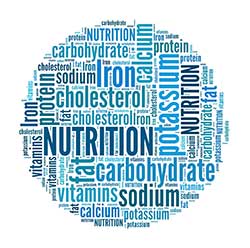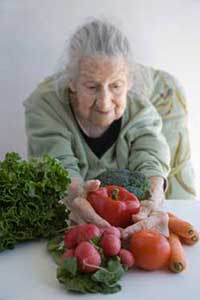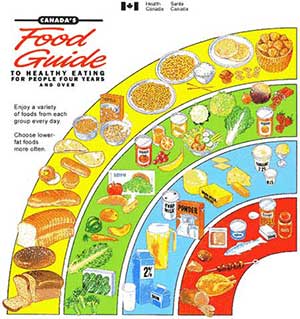
- Good nutrition can improve the overall health and support body function in people of all ages.
- Making or helping to prepare nutritious meals and snacks is an important part of caring for your family member or client.
- For a balanced diet, choose a variety of foods from the four food groups of Canada's Food Guide.
- Call your health care provider during office hours if your client or family member has weight loss, dehydration, loose bowel movements, depression, coughing while eating or swallowing, dental problems or mouth soreness.
- Go to emergency if they have a sudden high temperature, signs of confusion, dizziness, falling or pass out.
Nutrition plays an important role in healthy living for older adults. Eating well can improve the how the body functions. When caring for your family member or client it is important to understand the: effects of aging on nutrition, risk factors for poor nutrition and guidelines for a healthy diet. Poor nutrition can lead to weakness and disability. Frailness is not always a result of aging or disease. Nutrition screening should be a routine part of the care of older people as it helps to identify those in need of assistance and care.
Aging Changes that Affect Nutrition
 As people age, they need less energy but more nutrients to
maintain their health. As the human body gets older, it loses muscle mass over time. This results in the need for fewer daily calories to maintain weight and strength. If your family member is less active, they may also require less food and fluid
during the day. The following is a list of age related changes that may affect how much your family member or client eats or drinks:
As people age, they need less energy but more nutrients to
maintain their health. As the human body gets older, it loses muscle mass over time. This results in the need for fewer daily calories to maintain weight and strength. If your family member is less active, they may also require less food and fluid
during the day. The following is a list of age related changes that may affect how much your family member or client eats or drinks:
- loss of taste and smell causing food to taste bland
- loss of the awareness of thirst
- loss of muscle mass
- loss of bone mass
- decline in the rate energy is used
- slowing of how fast the stomach empties
Risk Factors for Poor Nutrition
Older people may face many other challenges that can lead to poor nutrition. These include the following:
- social isolation or being alone at meal times
- loss of appetite
- memory problems or dementia
- depression
- poor dentition or ill-fitting dentures
- low or limited income
- lack of transportation to get healthy food
- medical problems or chronic diseases
- many diet restrictions
- alcohol or substance abuse
- lack of motivation to cook or eat healthy foods
- difficulty swallowing
- unable to prepare meals or feed oneself
- constipation leading to a feeling of fullness
- difficulty breathing and eating at the same time
Canada's Food Guide

This table shows the recommended daily number servings from each food group for people aged 51 and older.
|
|
Female |
Male |
|
Vegetables and Fruit |
7 |
7 |
|
Grain Products |
6 |
7 |
|
Milk and Alternatives |
3 |
3 |
|
Meat and Alternatives |
2 |
3 |
Examples of serving sizes for each group:
- Vegetables and Fruit – 250 mL (1 cup) leafy salad, 125 mL (½ cup) vegetables, 125 mL (½ cup) canned fruit, 1 piece of fruit, 125 mL (½ cup) fruit juice
- Grain Products – 124 mL (1/2 cup) rice or pasta, 30g cold cereal, 175 mL (3/4 cup) hot cereal, 1 slice (35 g) of bread, ½ a pita or tortilla.
- Milk and Alternatives – 250 ml (1 cup) milk, 175 g (3/4 cup) yogurt, 50 g (1 ½ oz.) cheese, 250 mL (1 cup) soy beverage.
- Meat and Alternatives – 75 g (2 ½ oz. or ½ cup) meat, fish or poultry, 175 mL (3/4 cup) cooked beans or legumes, 150 g (3/4 cup) tofu, 60 mL (1/4 cup) shelled nuts and seeds, 30 mL (2 Tbsp.) peanut or nut butters.
As a person ages, the need for the following nutrients increase: protein, vitamin D, calcium and vitamin B12. The Meat and Alternatives group and Milk and Alternatives group are sources of protein in the diet. Canada’s Food Guide recommends everyone over the age of 50 take a daily vitamin D supplement of 10 µg (400 IU). Vitamin D and calcium are important for bone strength, reducing the risk of osteoporosis and preventing fractures in older adults. The Milk and Alternatives group provide the most amount of calcium. Vitamin B12 supplements may be need for your family member or client as absorption of vitamin B12 is reduced with age. Vitamin and/or mineral supplements maybe prescribed daily to ensure optimal health. It is important they are taken as prescribed.
Tips for Improving Nutrition
 Preventing poor nutrition is much easier than treating it.
So it is important to:
Preventing poor nutrition is much easier than treating it.
So it is important to:
- Offer meals and snacks throughout the day.
- Provide one food from each food group at each meal.
- Offer one food from two food groups at each snack.
- Encourage your family member or client to drink plenty fluids during the day.
- Offer fruit to eat rather than in juice as it provides fibre.
- Choose darker-coloured vegetables and fruits as they have higher levels of vitamins and minerals.
Improving Food Intake
Here are some ways to improve your family member or clients intake:
- if possible, avoid restricted diets
- cater to food preferences
- eat meals with your client or family member
- prepare foods of proper consistency, temperature and consider presentation
- improve the taste of food with herbs and spices
- avoid choosing hard-to-open packaging
- serve the largest meal when your client or family member has the most energy
- keep distractions to a minimum at meal times
When to Get Medical Help
Go to emergency if your client or family member experiences:
- a sudden high temperature or signs of confusion – people who do not eat or drink well are more prone to infections.
- dizziness, falling or passing out - this could be a result of weight loss.
Call a doctor during office hours to discuss any of the following symptoms:
- weight loss of 5% or more in one month or a loss of 10% or more in 6 months
- dehydration
- loss of appetite
- loose bowel movements
- coughing while eating or drinking
- dental problems or mouth soreness
Canada's Food Guide
- Eat well with Canada's Food Guide! Learning more about Canada's Food Guide will help you and your family know how much food you need, what types of foods are better for you, and the importance of physical activity in your day.
- Use the left-side menu to navigate this series of nutrition-related webpages that include information about causes and symptoms, diagnosis and tests and care and treatment.
- A series of frequently asked questions about seniors' nutrition. Be sure to view all three pages by using the navigation control at the bottom of the page to view.